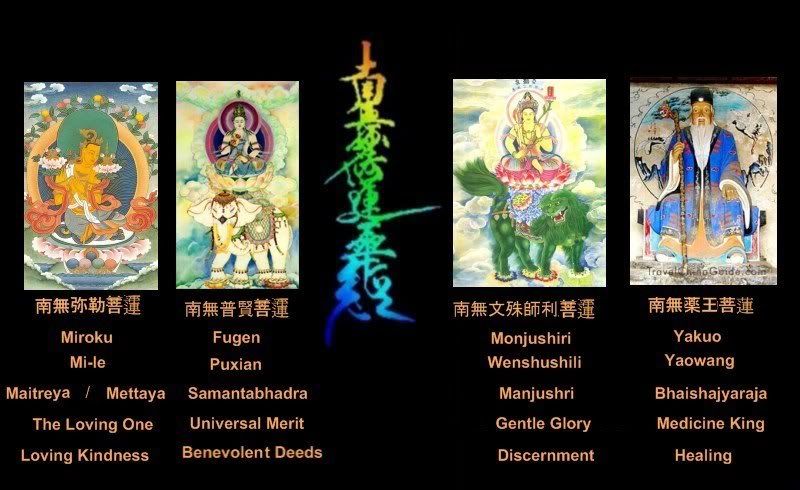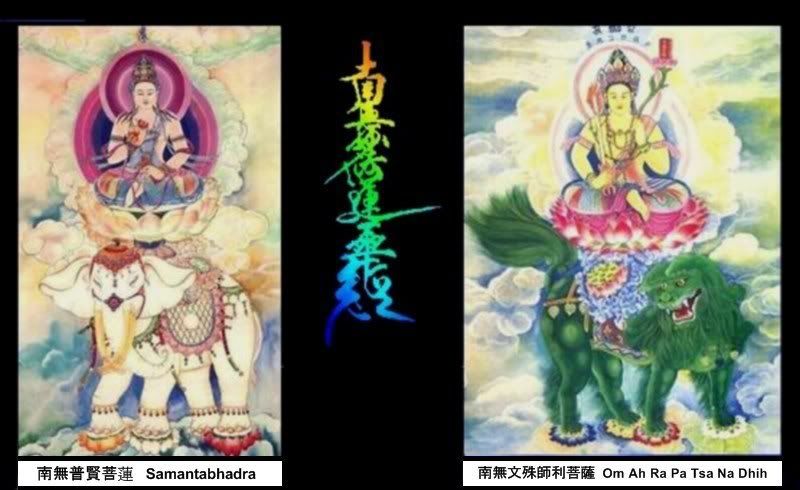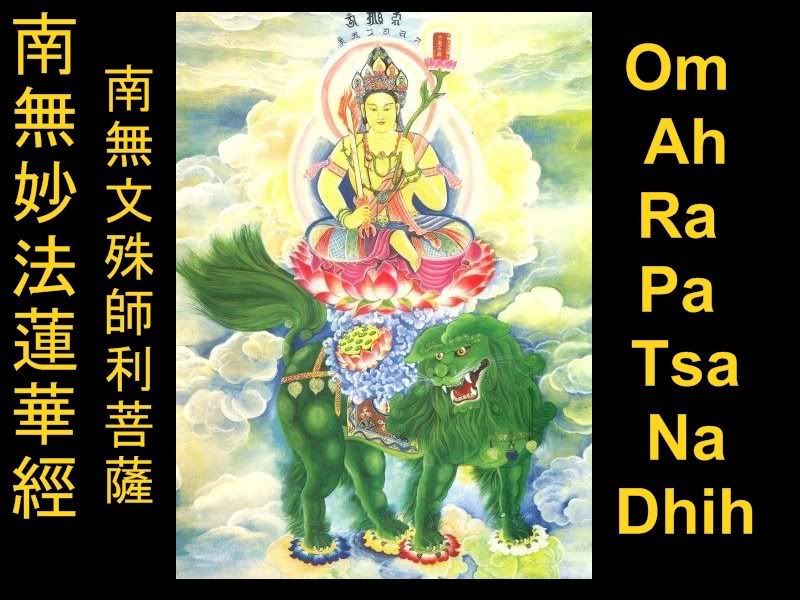There are a number of ways to behold Manjusri, whio is Buddhism's Great Patron Bodhisattva of Discerning Wisdom, while chanting his mantra: Om Ah Ra Pa Tsa Na Dhih. One of these is to visualize his presence at the Ceremony in Open Space, as depicted in calligraphy on Nichiren Shonin's Gohonzon. Monju {文殊} and Samantabhadra 普賢 {Puxian / Fugen} are among four Trace Gate 迹門 {shakumon} Bodhisattvas from the Lotus Sutra; who were chosen by Nichiren Shonin to be represnted on his Great Mandala Gohonzon. The other two are Bhaishajyaraja 薬王 {yakuo}; who represents healing, and Maitreya 弥勒 {miroku}; the Coming Samyaksambuddha who represents kindness {Metta / Maitri}. Monju symbolizes Discerning Wisdom, a discipline of of the Conceptual Mind or the Samjna Skandha; while Fugen symbolizes Benevolent Action, a which can be taken as a discipline of Body and Form or the Rupa Skandha.
Together with Samantabhadra {Fugen}, Monju is said to have attended the Historical Buddha Shakyamuni. They are often paired opposite each other on mandalas or in statuary configurations, flanking Shakyamuni. On most of Nichiren's very formal Ten Worlds Great Mandala Gohonzons; Monju and Fugen are on opposite sides of the central Daimoku, they occupy the inner most positions in the second row from the top. Namu Monju Shiri Bosatsu [南無文殊師利菩薩] is positioned directly below Namu Taho Nyorai [南無多宝如来] on the left of the mandala, which is your right.
That will work for copies the Shutei Honzon, the Denpo Honzon, and the Kito Honzon; as well as the Nittatsu & Nikken Transciptions issued by Taisekiji. Note that the Trace Gate Bodhisattvas are omitted in the SGI Nichikan Gohonzon; you will not find them there. The Mannen Kugo Daihonzon of 1274 is configured quite a bit differently, but you will find Monju in about the same position, except that Fugen is on the same {left, right facing} side, to Monju's left {your right}. On the Ichinen Sanzen Honzon; iirc, Nan {南} Mu {無} Monju {文殊} Fugen {普賢} Bosastsu {菩薩} is the third entry on your left, facing, reading right to left.
The Manjushri mantra is said to enhance explaining, debating, writing, critical thinking, memory, and so on. According to Wildmind: "Manjushri is associated with ordinary intelligence and mental accuity as well as transcendent Wisdom, and his mantra Om A Ra Pa Ca Na Dhih is said to confer intelligence. Shantideva, the author of the great Bodhicaryavatara ("Guide to the Bodhisattva’s Way of Life") is said to have gained his wisdom by communing with Manjushri by night, while appearing by day as a slovenly and lazy scholar-monk."
I also see Manjushiri as the Trace Gate parallel of the Source Gate Mahasattva Bodhisattva Anantacaritra 無辺行 {muhengyo}; who represents the innate virtue {guna} of Immediacy / Constancy or nicca / Nitya 常住 {joju}. So Monju would be like a sketch, conception, perception, and gradual achievement of Emptiness / Timelessness; while Muhengyo is its omnipresent reality. Note that the one of the primary Buddhist words for Eternity or Infinity; Nicca / Nitya 常住 {joju} means both constancy and immediacy. When we think of eternity; we tend to imagine some time in the remote past or distant future. Infinite space conjures up images of far away galaxies. However, Nitya is right here, right now, always.






No comments:
Post a Comment